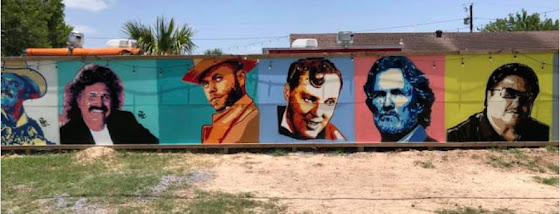(As local nusicians begin to fill a mural behind the Broken Sprocket on Paredes Lines Road, someone noticed that – as usual – the most famous female singer from Brownsville who gained fame worldwide and was known as "La Reina del Bolero" was missing from the wall. Mazz's Jimmy Gonzalez is on there as is Kris Kristofferson, San Benito's Freddy Fender and even includes Bill Haley, a Michigan native who died in Harlingen in 1981. Ramon Ayala, a native of Monterrey, Nuevo Leon, resettled in Hidalgo, is also there. But where's Brownsville's own Chelo Silva? Is local music only recognizing musical HIStory? What about HERstory, guys?)
By Juan Montoya
We have written in the past written about the fire that destroyed the 123 Lounge, an institution on Brownsville's 14th Street strip of honky-tonks and beer joints.
But while owner Javier Ruiz set about rebuilding the bar, someone reminded us that before it was a tavern, it was also a restaurant owned by none other than the parents of Chelo Silva, one of the pioneers of traditional Mexican music.
In fact, she used to wait on tables for her parents as child.
Her biographers say that Chelo, called La Reina del Bolero (Queen of the Bolero), reigned over Tejano music scene with her romantic ballads and passionate performances in 1940s and into the 1960s.
She was born Consuelo Silva on August 25, 1922, in Brownsville, the oldest of seven children. She began singing as a teenager at school and in her church (Guadalupe Catholic Church on Lincoln Street). In fact, locals say her first public performance was at a Guadalupe Church Kermess.
Retired pharmacist Vincent Crixell said Chelo had been noticed by local musicians while still in her early teens. A few years later, she was singing regularly with a local group, the Tito Crixell Orchestra, headed by Vincent's father.
"Chelo performed in the first Charro Days in 1938," he remembered. "My dad had to ask permission from her parents so she could sing."
Her online biography said Chelo made her mark on a wider audience in 1939 when she was asked to sing on a local radio program hosted by the poet, composer, and author Americo Paredes.
That radio show gave her wider exposure and opened the doors for her. It wasn't long before she was performing regularly at Corpus Christi's Continental Club. Silva also later married, and divorced, Paredes.
However, breaking into recordings was difficult for Chelo and it wasn't until she was 30 that she landed her first record deal with Discos Falcón of McAllen, Texas, where she would go on to record over seventy titles.
Liner notes on a compilation of her hits indicate that by 1955 she had signed with Falcon Records, Peerless Records, and finally Columbia Records.
The move paid off almost immediately as Silva put together an impressive string of hit songs, including "Cheque En Blanco," "La Huella de Mis Besos," “Imploración,” “Esta Sellado,” “Sabes de Que Tenga Ganas,” “Soy Bohemia,” “Inolvidable,” and “Amor Aventurero,” "Como Un Perro," etc.
A few bars in her old neighborhood had Silva's recording on their jukeboxes, notably the late Willy Garza's Border Lounge, Maria's El Siete Mares, and Mike Chapa's La Catorce Bar. Most of those bars, and those on Market Square – all gone now – had her most popular songs on the jukeboxes at four songs for $1.
The success of the Columbia recordings led to several touring opportunities throughout the Southwest and Mexico, including tours with then-notable stars such as José Alfredo Jiménez, Javier Solis, Vicente Fernández, and Lola Beltrán.
By the 1960s, Silva was the most well known of the female Spanish-language singers, her popularity reaching outside the United States and into Latin America. Silva died of cancer in 1988 at the age of sixty-five. Fortunately for fans and historians, much of her music has resurfaced in the form of reissues and compilations.
Following the death of the Tejana superstar Selena, there was a resurgence in the root music that had paved the way for younger generations. In 1995, Arhoolie Records released “Chelo Silva,” a best-of collection that includes some of Silva's most-loved songs, including “Imploración,” “Esta Sellado,” and “Amor Aventurero.”
Yet, Silva's memory has always been put down by people who criticized her being a woman performing in cantinas where a "decent" woman should not be. Author Deborah Vargas notes this in her "Borderland Bolerista" when comparing corrido performers like Paredes with women performers like Chelo:
"Yet almost always in the background were the references to Silva's inappropriate behavior as a woman. I learned quickly during my initial investigation of Silva's life that extramarital lovers, drinking, and sexual escapades were expected when the protagonist was a heterosexual man, but "inappropriate" as a sign of the sexual agency of women public performers."
Now, after her death, Chelo Silva remains one of the most influential figures in the history of Mexican music. And where do you think Chelo is best remembered? Not in her hometown, that's for sure. Except for some indications that Chicano-In-Residence Meme Maldonado at UTB-TSC was working on yet another cultural documentary, no one seems to remember that Chelo put Brownsville on the musical map.
"Brownsville is like that," Ruiz said. "We would rather recognize people from outside than to remember our own artists."
BOHEMIAN RHAPSODIES
By Rosa Canales Perez
Bohemian rhapsodies
Seldom find their place in Mexican-side of town cantinas
More beer than wine cantinas
Heavy with cigarette smoke
"El Monkey Lounge"
"El Mante Bar"
"El 1,2,3
Troubadors strapped with
Acordeon and bajo sexto
Wander in and out
But thumping wails
from stereophonic jukebox prevail
En el 1,2,3
A hard-living barrio poet
Stands back turned toward the rest
Hands upon the jukebox
Selecting his music
Like pulling a cork From a bottle of vintage rare
Until the voice of Chelo Silva fills the air
Chelo Silva...
Self-avowed Bohemian
Passionate
Elegant
Rebellious
Bending notes from
Shades of Mexican blue
One bolero after another
Torch songs aching with
Heartbreak, talent and
Never-ending hometown due
Chelo Silva
1950s Texas bolero queen
yet to be replaced
reigning from the grave
Cast in a cantina scene
With a hard-living barrio poet
Secure within the
Tolerance zone where
People don't ask
Too many questions
When the
Bohemian
Rhapsodies of an
Errant soul find
Their way back home
2002










17 comments:
frankly, never heard of her.
real.
Chelo... brilliant singer. So many that belong but there is limited space. It is up to the owners to decide what goes up. The city of Brownsville is who should showcase our local stars (from all walks of life) throughout our community.... if someone does an in-depth search, we have a lot of worthy candidates. We need to establish standards... guidelines. There’s plenty of wasted space around the city. But like everything else in this city ...everything is political
Good piece Juan. Gives credence to the old saying, “You haven’t made it till you make it in your home town. “
How about a wall of shame that would include: joe Rodriguez, Slyvia Atkinson, erasmo Castro, Juliet Garcia, Raul Besterio, Rene n David Oliveira ...the Lucio’s ... n there is many more lol
Group winners for hall of shame - port of Brownsville, Bisd board, tsc board, mayor n commissioners, Cc judge n his sidekicks n the group of podcasters that think they know it all...in second place BPD n the over rated fire department
Elfego Esparza Suggest updates
Born El Ranchito
American bass.
Elfego Esparza made his operatic debut as Leporello, continuing to perform the role throughout his career. He studied with the Italian baritone Enzo Mascheroni.
Appearances in the USA included both the New York Met and the San Francisco Opera. On the continent Esparza worked at the opera houses in Zurich, Dusseldorf, Munich, Vienna and Prague. He also sang at the Wexford Festival and at Glyndebourne. He made his Scottish Opera debut in 1968 as Hagen, returning in 1971 for Bartolo.
His repertoire included Mozart (Osmin, Leporello, Don Alfonso); Rossini (Don Geronimo Il turco in Italia, Bartolo); Donizetti (Don Pasquale); Verdi (Melitone); Wagner (Hagen) and Strauss (Baron Ochs).
American bass.
Elfego Esparza made his operatic debut as Leporello, continuing to perform the role throughout his career. He studied with the Italian baritone Enzo Mascheroni.
Appearances in the USA included both the New York Met and the San Francisco Opera. On the continent Esparza worked at the opera houses in Zurich, Dusseldorf, Munich, Vienna and Prague. He also sang at the Wexford Festival and at Glyndebourne. He made his Scottish Opera debut in 1968 as Hagen, returning in 1971 for Bartolo.
His repertoire included Mozart (Osmin, Leporello, Don Alfonso); Rossini (Don Geronimo Il turco in Italia, Bartolo); Donizetti (Don Pasquale); Verdi (Melitone); Wagner (Hagen) and Strauss (Baron Ochs).
No chinguen con David Oliveira. He was one of the greatest athletes to come out of Brownsville.
You must mean Johnny “o” and he was not great , just a good high school athlete
David Oliveira was not even good at playing marbles
They are going to make a statue of Chelo Silva by the entrance.
Two ass holes who hate veterans
I checked out the Esparza dude on the World Wide Web. What a success story. Homey had like thirteen siblings growing up on military hwy. got a scholarship and made it out of the RGV and eventually made his way through the international opera circuit eventually laying roots in Western Europe and propagating the continent with hard working RGV ethics. I think he deserves a place on the wall.
@ Jul 31,2021 at 11:01 PM
If you are refering to Jose and Rosa you're mistaken.
Shes missing from the wall because no one has heard of her lol they should add cool people/silver back gorilla
I remember going to McAllen with my mom & dad to find 45s for the pianola. Chelo Silva, Flor Silvestre , Lucha Villa, Mercedes Castro. All those ladies were always on the pianola, and we’re Definitely under-appreciated in comparison. Thanks for the memories, I can just about smell the vinyl in the bins of 45s and albums at Falcon with the posters of their artist hanging from the walls and ceiling.
July 31, 2021 at 12:34 PM
You wanna name a few gringos pinche COCO culo...
I know you aren’t directing that at me. I grew up on boleros & trios & rancheras. So how is that coco, if I hadn’t a clue about my own culture & named Radiohead & roxy music that’s coco. Either way go sober up & try to write something coherent.
Post a Comment